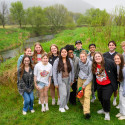Campus begins updating security cameras
As one of the nation’s newest hockey and swimming facilities, the University of Wisconsin–Madison’s La Bahn Arena has cutting edge amenities that help it stand out from similar construction on other campuses.
But it’s also unique here at home, as the first campus building to be completely outfitted with IP security cameras.
In partnership with Physical Plant, the UW Police Department has begun upgrading the campus standard for security cameras from analog to IP (wireless). The advantages of the new technology have already proven the wisdom of changing with the times.
With more than 1,000 cameras and storage devices scattered across 300 campus buildings, the process is immense. New construction takes precedence; buildings in the final stages or recently completed, such as La Bahn, Gordon Dining and Events Center and the new De Jope Residence Hall, are the first to receive the upgraded systems.
“Really good pictures have helped us solve a lot of crimes — identity theft, people stealing things inside buildings, or break-ins to the residence halls. You can’t cover it up, because we have the video footage.”
Sgt. Nick Banuelos
UWPD prepares a scope report for each proposed installation, noting the reasons for use – crime prevention, safety, other needs – and the ideal locations for the equipment.
“About half of our campus cameras and DVRs [digital video recorders] have reached their life expectancy. We’re pushing the limit at eight or nine years already,” says Sgt. Nick Banuelos, part of UWPD’s infrastructure security team. “With analogs, you were forced to physically hardwire the cameras, so distance and location were a major deciding factor. Now, you can locate the DVR in a completely different building if you want.”
UWPD is still learning the ins and outs of the new technology’s capabilities. Older cameras used motion-defined recording: simply recording any motion seen. The newer cameras can count the number of objects or people, including tracking motion through an exit – going the right or wrong way.
Analytics also play a larger role. Another Big Ten university analytics have helped track activity on a bridge known as a spot for “jumpers.” Using a lingering analytic within a predetermined time and area, the camera can notify police if an object or person stops within the range and lingers for a certain time. A convergence analytic, checking multiple objects converging on each other, can help monitor a location known for overnight robberies.
The biggest impact, though, comes from the clarity of images, upgrading from fuzzy, black-and-white pictures to high-definition color. Better images also help screen out people who were uninvolved in a crime – and encourage those who were involved to confess more quickly.
“Really good pictures have helped us solve a lot of crimes — identity theft, people stealing things inside buildings, or break-ins to the residence halls,” says Banuelos. “You can’t cover it up, because we have the video footage.”




